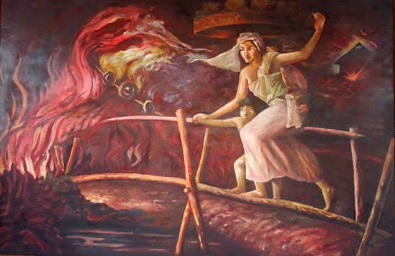Monograph title: Hanjabam Shyamo Sharma: Life, Times and His Art
Author: Thoidingjam Tombi Singh
Thoidingjam Tombi writes that Shyamo was a painter who wanted to establish strings between hearts, a fitting eulogy indeed to a great soul and artist. The author relives a forgotten artist. Unlike RKCS or Bhadra, chances are you would not have heard of Shyamo. But you might have seen a painting of his – a woman crossing an Urokthong (bamboo bridge) with her two children and a basket of vegetables on her head, amid fires from an explosion in the distance, perhaps on the cover of a poetry book or at an Art Exhibition somewhere. That is Hanjabam ShyamoSharma’s masterpiece.
Tombi himself is an artist, in fact a student of Shyamo. But once, when he stopped going to his home for tutoring because of his upcoming CC School exam, Tombi recalls how Shyamo came in person to his house and asked Tombi’s father to send his son on Sundays at least. That was way back in the 1950s.
Shyamo Sharma’s life was painful but his courage to struggle was matchless. As a boy, when his father Radhamohan married a second time, he faced an unhappy family. He became a withdrawn boy who took solace in watching Nature, and was often lost in thoughts. Ningthem Pukhri tank, dug by Maharaja Garibiniwas was close to his home and on its banks, he would sit and watch the waters. Soon, Nature came to inspire his paintings.
But it was not until he ran away from home to Silchar that he formally took lessons in painting. He was around 20 years of age at that time and he learnt painting from one Shushila Devi. But after three years, he got tired of life at Silchar. So he returned home.
His father had left him some money before he died. With that money, he opened a shop at Kongba Keithel. But it was a fiasco. And a day changed his life.
He was sketching when Jelly Memsaheb, a British woman who was fond of painting, saw him sketch her features and immensely appreciated him. That spurred him to learn more of painting from Mangsidam Kalachand Singh, a student of Court Painter Bhadra Singh.
When he finished his course, he was confident enough to set up his own painting shop. He drew paintings related to Vaishnava religion, and connected himself with Wangkhei’s Paradise Hall and, of course, with Aryan Theatre. He painted the scenes of the Plays he saw. At the same time, he taught students at several places, though fees were seldom realised. His cycle and table clock was mortgaged frequently. Financial difficulties being recurrent, he bought earthen pots and painted them with frescoes to resell them after value addition.
But as Tombi writes Shyamo wanted to establish painting on the soils of Manipur. So what he did was to reserve a plot of land near the Imphal War Cemetery, by continuous requests to the government, and in league with other like-minded citizens, set up the Imphal Art School in 1949. In 1959, it was upgraded to Imphal Art College.
Tombi said he was a surrealist painter, and certainly the masterpiece mentioned earlier was surrealist – a mix of fact and imagination on an episode during the 2nd World War. Certainly, Shyamo’s other paintings – Mother and Child, Inn Chingbi (Fisher woman), Mother Manipur after the 1891 Khongjom Battle – were based on facts but he added from his own imagination to express his mind. Perhaps, I may not be wrong if I say he is the most gifted painter Manipur has seen. I pause to think how he managed to paint in the midst of his aching poverty. As writer Tombi – he is himself a Professor of Fine Arts now – says in this thesis of September,2018,” He (Shyamo) had not received any grant from the government and his life was of distress and deprivation”.
Indeed, Shyamo suffered and wants and deprivation characterise his life though he was never complacent in his vision of establishing a Manipuri art. Two stages comprise his career, first when he painted on themes related to Hindu religion at the pavilion of Gurumayum Brajamani Sharma at Singjubung Leirak and second when his paintings depicted themes arising after the 2nd World war. While comparing Manipur to a soft lotus, Tombi writes, Painter Shyamo portrayed the unbroken unity and integrity of Manipur.
Tragically, when Imphal Art College started to receive some grants from the government in 1975, his health deteriorated and four years later on 16 September,1979, he breathed his last. Today, Shyamo is no more but his paintings live to tell the saga of a painter’s struggle – fraught with poverty and pains. It is a wonder how the painter produced his masterpieces in the face of such appalling miseries that would wrecked any man.












